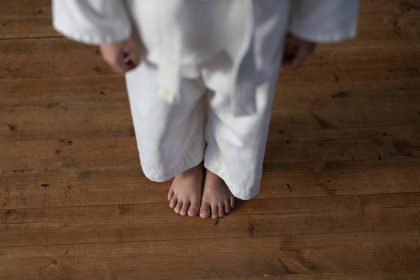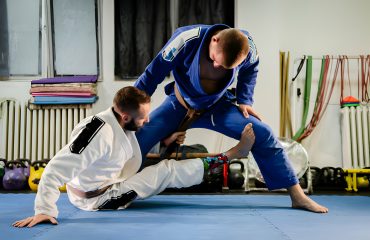
In today’s world, the ability to defend oneself is invaluable. Brazilian Jiu-Jitsu (BJJ), known for its effectiveness in close combat, offers a comprehensive approach to self-defense that is accessible to individuals at all stages of their martial arts path. At NOCO Jiu-Jitsu, we specialize in equipping white belt BJJ practitioners with the skills they need to not only excel on the mats but also protect themselves in real-world situations. Our program is designed to build a solid foundation in BJJ techniques, ensuring that even beginners can start applying what they learn from day one. This approach empowers our students, giving them the confidence and competence to handle potential threats effectively.
Understanding the Fundamentals of BJJ
The cornerstone of successful self-defense in Brazilian Jiu-Jitsu (BJJ) rests on a thorough comprehension of its basics. We stress the significance of mastering fundamental positions, movements, and principles that underpin BJJ’s self-defense prowess. This essential understanding is vital as it lays the foundation for mastering advanced techniques. Lacking a firm grip on these basics could hinder practitioners from executing complex maneuvers efficiently, particularly in critical, high-pressure scenarios where self-defense abilities are paramount.
Moreover, the fundamentals of BJJ teach practitioners not just about physical techniques but also about the strategic aspects of self-defense. Understanding how to control an opponent, maintain balance, and leverage one’s own body weight plays a significant role in neutralizing threats. These principles are applicable beyond the mats, offering valuable insights into how to handle confrontations calmly and efficiently. Mastery of the basics thus equips individuals with a versatile set of skills that enhance their ability to protect themselves in various scenarios, making the study and practice of BJJ fundamentals an indispensable part of self-defense training.
The Role of Mindset in Self-Defense
The mental component of self-defense is often as critical as the physical techniques themselves. A resilient mindset not only enhances the effectiveness of these techniques but also determines one’s ability to respond under pressure. Brazilian Jiu-Jitsu (BJJ) training places a significant emphasis on developing this mental fortitude, teaching practitioners to remain calm and focused, even in the face of adversity. This mental resilience is cultivated through consistent practice, scenario-based training, and the development of a strategic approach to problem-solving on the mats, which translates directly into self-defense situations.
Understanding and developing the right mindset for self-defense involves several key components:
- Awareness: Being aware of your surroundings and potential threats is the first step in self-defense. This heightened sense of awareness helps in avoiding dangerous situations before they escalate.
- Confidence: Confidence, built through mastering BJJ techniques, directly impacts your ability to handle confrontations. A confident demeanor can deter potential attackers and give you the psychological edge in a defensive scenario.
- Calmness: The ability to stay calm under pressure allows for clearer thinking and better decision-making. BJJ training teaches you to breathe, think, and then act, rather than reacting impulsively to a threat.
- Resilience: Mental resilience enables you to push through fear, pain, and fatigue. It’s about the determination to protect oneself and the perseverance to continue fighting, even when the odds seem against you.
- Adaptability: Every self-defense situation is unique. Being mentally prepared to adapt and apply BJJ techniques creatively is crucial. This flexibility in thinking ensures you can respond effectively to dynamic and unpredictable situations.
By focusing on these mental aspects, BJJ practitioners develop a comprehensive skill set that prepares them for real-world self-defense. The training goes beyond physical confrontations, instilling a mindset that prioritizes safety, assesses risks intelligently, and responds to threats with a balanced combination of confidence and caution. This holistic approach to self-defense ensures that individuals are not just physically prepared to defend themselves but are also mentally equipped to navigate the complexities of real-life confrontations.
Essential Techniques for White Belts
White belt practitioners in Brazilian Jiu-Jitsu must prioritize mastering a fundamental set of techniques to establish a strong base in both self-defense and competitive grappling. Proficiency in these foundational moves not only paves the way for advanced learning but also boosts confidence in their self-protection skills. Emphasizing these key maneuvers enables novices to grasp essential BJJ principles like leverage, timing, and positioning comprehensively.
Here, we outline essential techniques that every white belt should prioritize:
- Basic Escapes: Learning to escape from common positions such as the mount, side control, and back control is vital. These techniques teach practitioners how to regain a more advantageous position or return to a neutral state when an opponent has gained the upper hand.
- Guard Retention: The ability to maintain the guard prevents opponents from advancing to more dominant positions. White belts should focus on techniques that allow them to control an opponent from the bottom and utilize their legs to create barriers and manage distance.
- Basic Submissions: Familiarity with fundamental submissions like the armbar, triangle choke, and rear-naked choke equips white belts with the tools to finish a match or defend themselves effectively. Understanding the mechanics and setups for these submissions is key.
- Sweeps from Guard: Sweeps are techniques used to reverse positions, moving from a bottom position to a top position. Learning basic sweeps from the guard position, such as the scissor sweep and the hip bump sweep, allows practitioners to turn defensive positions into offensive opportunities.
- Positional Control: Understanding how to control an opponent from top positions like mount, side control, and back mount is essential. This includes learning how to distribute weight, use pressure effectively, and transition between positions to maintain dominance.
By concentrating on these fundamental techniques, white belts can build a strong base in BJJ, enabling them to progress more quickly and become more effective in both self-defense scenarios and competitive settings. Mastery of these basics sets the stage for advanced learning and allows practitioners to approach their training with confidence and a solid understanding of BJJ’s core concepts.
Building a Defensive Game
In Brazilian Jiu-Jitsu, a well-rounded defensive game is essential for both competition and self-defense scenarios. For white belts, focusing on defense early on lays a solid foundation for future growth in the sport. Developing these skills requires a strategic approach, emphasizing technique, awareness, and the ability to anticipate an opponent’s moves.
Here are key strategies and principles for white belts to enhance their defensive capabilities:
- Master the Basics: Before diving into complex techniques, ensure a strong grasp of fundamental positions and escapes. Understanding how to effectively use the guard, achieve and maintain a safe posture, and escape from common holds are the cornerstones of a solid defense.
- Positional Awareness: Always be aware of your position relative to your opponent. Knowing whether to advance, maintain, or change your position can prevent you from getting into vulnerable spots. This awareness is crucial in deciding when to defend or switch to an offensive strategy.
- Drill Escapes Regularly: Escapes are a critical part of your defensive toolkit. Regular drilling of escapes from mounts, side controls, and back controls will prepare you to react swiftly and efficiently when an opponent attempts to submit you.
- Learn to Frame and Create Space: Effective use of framing to create space between you and your opponent is vital. This not only helps in defending against submissions but also in setting up your escapes. Understanding the mechanics of using your arms and legs as frames against an opponent’s pressure can significantly improve your defensive game.
- Breathing and Remaining Calm: Often overlooked, the ability to control your breathing and remain calm under pressure is a defensive skill in itself. Panic can lead to rushed decisions and mistakes. Practicing calmness, even in adverse positions, allows for clearer thinking and better decision-making.
By focusing on these areas, white belts can develop a defensive game that not only protects them against more experienced practitioners but also lays a strong foundation for their progression in Brazilian Jiu-Jitsu. Remember, defense is not just about avoiding being submitted; it’s about controlling the situation to your advantage, even when under pressure.
Offensive Techniques for Self-Defense
Mastering the ability to transition from defense to offense is vital for personal safety, and Brazilian Jiu-Jitsu (BJJ) equips practitioners with offensive techniques aimed at efficiently neutralizing threats. These techniques focus on controlling a situation to safely escape danger, rather than promoting aggression. For white belt practitioners, learning and applying a select number of these offensive strategies can significantly improve their self-defense skills. By leveraging BJJ’s principles, even those new to martial arts can effectively defend against larger or stronger adversaries, enhancing their ability to protect themselves in a variety of situations.
Here are five essential offensive techniques that can be employed in self-defense situations:
- The Rear Naked Choke: A fundamental BJJ technique that can incapacitate an attacker from behind. It focuses on applying pressure to the carotid arteries, leading to temporary unconsciousness if necessary, allowing for an escape.
- The Armbar: This technique can be applied from various positions but is most effective when securing an attacker’s arm between your legs, and applying pressure to the elbow joint. It’s a control technique that can persuade an attacker to cease their aggression.
- The Guillotine Choke: Useful when an attacker is in front of you, this choke involves encircling the neck with the arm and applying pressure. It’s particularly effective in close combat situations.
- The Triangle Choke: This technique uses the legs to execute a choke from the bottom position, making it ideal when an attacker has you pinned to the ground. It’s a testament to BJJ’s principle of using the opponent’s force against them.
- The Kimura Lock: A shoulder lock that applies torque to the shoulder joint, making it highly effective in controlling or neutralizing an attacker. It can be initiated from various positions, making it a versatile technique in self-defense.
Each of these techniques requires practice to execute effectively, especially under the stress of a real-life confrontation. However, even at the white belt level, practitioners can begin to learn these moves, understanding the mechanics and principles behind them. The goal is not to engage in prolonged combat but to create an opportunity to escape harm. Through consistent training, individuals can develop the muscle memory and confidence needed to apply these techniques effectively, turning potential vulnerabilities into strengths in self-defense situations.
Physical Conditioning and BJJ
Physical fitness is essential for maximizing the effectiveness and safety of Brazilian Jiu-Jitsu (BJJ) techniques in both competitive environments and real-world self-defense scenarios. A comprehensive physical conditioning program enhances a practitioner’s ability to perform techniques with precision, maintain control in various positions, and reduce fatigue during extended training sessions. Such conditioning not only improves performance and self-defense efficacy but also significantly reduces the risk of injuries by fortifying the body’s muscles and joints. Beyond physical benefits, a strong conditioning regimen also boosts mental health, lowers stress, and builds confidence, equipping BJJ practitioners with the strength, flexibility, and endurance needed to succeed on and off the mats.
Here are five key components of an effective physical conditioning program for BJJ practitioners:
- Strength Training: Building muscle strength, especially in the core, legs, and arms, enhances the power behind techniques and the ability to resist opponents’ moves.
- Cardiovascular Endurance: High-intensity interval training (HIIT) and steady-state cardio improve heart health and stamina, allowing practitioners to maintain high energy levels throughout sparring sessions and matches.
- Flexibility and Mobility Work: Regular stretching and mobility exercises increase the range of motion, making it easier to perform a wide array of BJJ techniques and reduce the risk of muscle strains.
- Balance and Coordination Drills: Exercises that improve balance and coordination are essential for executing complex moves and maintaining positional control during grappling exchanges.
- Injury Prevention Routines: Incorporating exercises that strengthen injury-prone areas, such as the knees and shoulders, can prevent common BJJ injuries, ensuring practitioners spend more time training and less time sidelined.
By prioritizing physical conditioning, BJJ practitioners can significantly enhance their performance, safety, and overall experience in the sport. This comprehensive approach to fitness ensures that individuals are prepared not only for the physical challenges of BJJ but also for the demands of self-defense in real-life scenarios.
The Importance of Drilling and Sparring
Regular practice and sparring are indispensable components of Brazilian Jiu-Jitsu training, playing a crucial role in the development of a practitioner’s skill set. Through consistent drilling, students engrain essential techniques into muscle memory, allowing for more fluid and instinctive responses during live sparring sessions. Sparring, on the other hand, provides a dynamic environment where practitioners can test their skills against resisting opponents, simulating real-world self-defense scenarios. This combination of drilling and sparring ensures that techniques are not only learned but also effectively applied under pressure.
- Technique Refinement: Drilling allows for the repetition of specific movements, leading to improved accuracy and efficiency. Over time, this repetition helps in refining the nuances of each technique, making them more effective.
- Pressure Testing: Sparring exposes practitioners to the unpredictable nature of a real confrontation. It tests their ability to apply techniques under stress and adapt to the fluid dynamics of a fight.
- Strategic Thinking: Engaging in sparring sessions enhances a practitioner’s ability to think strategically in combat situations. It fosters quick decision-making and helps in developing a game plan against different types of opponents.
- Conditioning: Both drilling and sparring contribute to physical conditioning, improving cardiovascular health, strength, and endurance. This physical preparedness is crucial for the demands of self-defense situations.
- Feedback Loop: Sparring serves as an immediate feedback mechanism, highlighting areas of strength and those needing improvement. This feedback is essential for targeted growth and development in BJJ.
By integrating regular drilling and sparring into their training regimen, white belt practitioners can significantly accelerate their learning curve, enhancing both their technical proficiency and their ability to apply BJJ principles effectively in self-defense scenarios.
Adapting BJJ Techniques for Real-World Scenarios
Adapting BJJ techniques for real-world scenarios involves understanding the context in which these skills might need to be applied. Unlike the controlled environment of the dojo, real-life situations are unpredictable and can vary greatly in terms of space, aggressor behavior, and potential dangers. Practitioners learn to modify techniques to suit these conditions, focusing on maintaining control and ensuring personal safety. For instance, the principles of leverage and technique over strength become even more crucial when facing an assailant in an uncontrolled environment. This adaptability is a core aspect of BJJ training, emphasizing the art’s practicality and effectiveness in real-world self-defense.
Incorporating BJJ techniques into real-world self-defense strategies also requires a keen awareness of one’s surroundings and the ability to assess situations quickly. Practitioners are taught to recognize when to engage physically and when to employ de-escalation tactics or escape maneuvers. This decision-making process is integral to the effective application of BJJ outside the dojo, ensuring that individuals can protect themselves while minimizing harm to themselves and others. The focus on ground control and submission holds, for example, allows for the neutralization of threats without relying on striking, aligning with the goal of self-defense rather than aggression. Through continuous practice and scenario-based training, BJJ practitioners develop the confidence and skills necessary to navigate and respond to potential threats in everyday life.
Safety Tips for Self-Defense Situations
In the domain of self-defense, being prepared is half the battle. Understanding how to avoid and steer through dangerous situations can significantly reduce the risk of harm. Here are some essential safety tips and best practices designed to help individuals, especially white belts in Brazilian Jiu-Jitsu, handle potential threats with wisdom and confidence.
- Stay Aware of Your Surroundings: Always be conscious of your environment and the people around you. This heightened awareness can help you recognize and avoid potentially dangerous situations before they escalate.
- Trust Your Instincts: If something feels off, trust your gut feeling. It’s better to err on the side of caution and remove yourself from a situation that seems threatening or unsafe.
- Maintain a Strong Posture: Presenting yourself with confidence can deter potential attackers. A strong, assertive posture signals that you are not an easy target.
- Keep a Safe Distance: If you sense danger or find yourself in a confrontation, try to maintain a safe distance from the threat. This space can give you more time to react and make decisions.
- Use Your Voice: Don’t be afraid to use your voice to assert boundaries, call for help, or de-escalate a situation. A firm, loud voice can attract attention and help deter an attacker.
By incorporating these safety tips into your daily life, you can enhance your ability to protect yourself in various scenarios. While Brazilian Jiu-Jitsu provides the techniques necessary for physical defense, combining these skills with strategic awareness and preventive measures can significantly improve your overall safety and confidence in self-defense situations.
Leveraging NOCO Jiu-Jitsu’s Community and Resources
Being part of the NOCO Jiu-Jitsu community offers white belts a supportive environment to accelerate their learning. We’ll highlight how our resources, seminars, and workshops can enhance your self-defense skills. Beyond the technical training, the sense of camaraderie and shared purpose within our community plays a crucial role in a practitioner’s development. Engaging with fellow students and instructors provides a network of encouragement and advice, fostering a learning atmosphere that is both challenging and supportive. This community aspect ensures that every member, regardless of their level, receives the motivation and feedback necessary to progress. Our seminars and workshops, led by experienced practitioners, offer unique insights into the application of BJJ in self-defense scenarios, enriching the learning experience and providing practical knowledge that can be applied both on and off the mats.
Mastering self-defense as a white belt BJJ practitioner is a process of continuous learning and practice. At NOCO Jiu-Jitsu and Self-Defense, we are committed to guiding you through this process, providing the training, support, and community you need to develop effective self-defense skills.
Ready to begin your self-defense adventure with BJJ? Join us at NOCO Jiu-Jitsu for personalized training and guidance. Whether you’re a complete beginner or looking to enhance your skills, our trial classes, seminars, and workshops are designed to meet your needs. Contact us today to learn more and become part of our thriving community.




